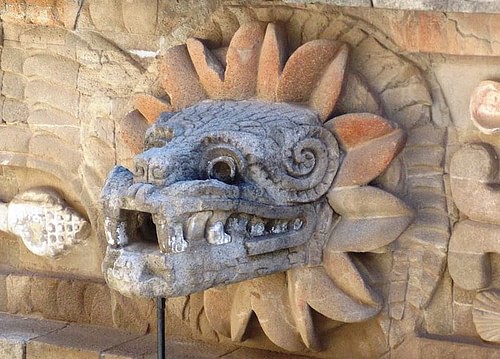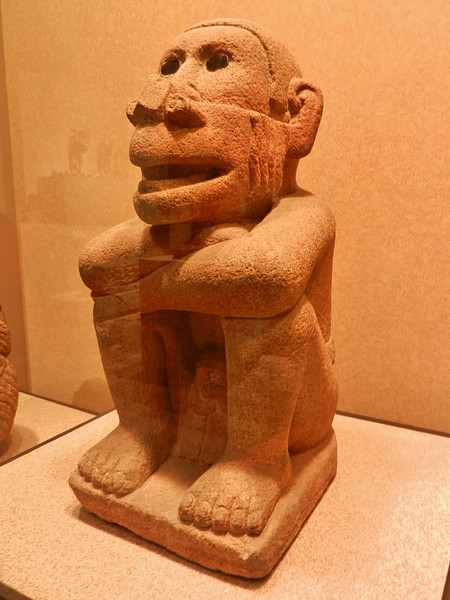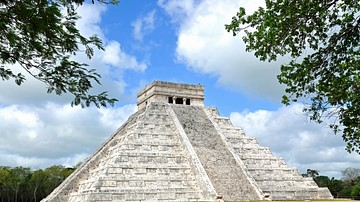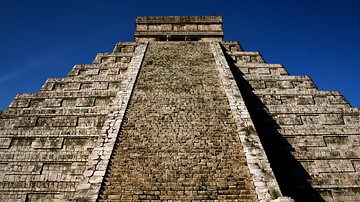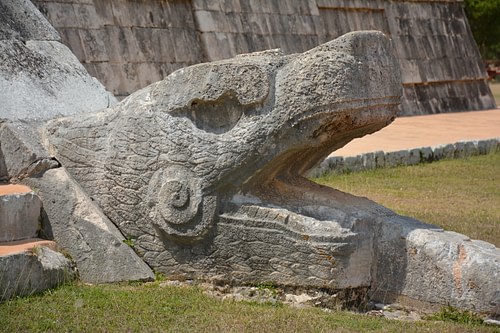
Kukulcan (pron. Koo-kool-kan) is the name of a feathered serpent god in the mythology and religion of Mesoamerica, in particular, the Yucatec Maya. He is also identified as the feathered serpent god Quetzalcóatl by the Toltecs and Aztecs, as Gucumatz to the Quiché Maya of Guatemala, and Ehecatl, the wind god of the Huastecs of the Gulf Coast.
Kukulcan and his other manifestations are all unified by the belief that each was considered a creator god and a bringer of rain and winds. The god is particularly associated with Chichen Itza where a large temple was built in his honour. Kukulcan is also the name of a 10th-century CE cultural hero in Yucatec Maya history, and he has a counterpart in the Toltec and Aztec histories where he carries the name Ce Acatl Topiltzin Quetzalcóatl. The feathered serpent god remains today a powerful symbol of Mexican indigenous cultural heritage.
Kukulcan & the Yucatec Maya
The Yucatec Maya were (and still are) speakers of the Yucatec language, and they settled the Yucatan peninsula in the north of ancient Mesoamerica. Their chief god was the feathered serpent Kukulcan whose name means just that: feathered (k'uk'ul) and serpent (kan). He was a creator god, and the god of rain, wind, storms, and life. Throughout Mesoamerica, the snake, because of its living habits, became a symbol for life both below and above the earth, and so it was considered a point of connection between the gods and humanity. The open mouths of snakes were identified with caves, which give access to the underworld, and their bodies are often given sky symbols in Mesoamerican art. Further, the Maya words for sky and snake have the same pronunciation. The figure first appears, albeit rarely, in carvings of the Olmec civilization, which prospered in Pre-Classical (Formative) Mesoamerica from c. 1200 BCE to c. 400 BCE. Not a great deal more is known about Kukulcan except that the god had major temples dedicated to him at Chichen Itza, Mayapan, Uxmal, and others.
In addition to the god Kukulcan, the Yucatec Maya believed that a man called Kukulcan - a cultural hero who is either a ruler or priest - had, some time in the 10th century CE (perhaps 987 CE), come to or even founded Chichen Itza in the northern tip of the Yucatan peninsula. This individual and his followers had come from the legendary city of Tula/Tollan (a name often applied to any large settlement). In some Maya legends, it was said that Kukulkan and his followers took the city by force, defeating the city's first settlers, whom the Maya called the Itza. The hero Kukulcan is also credited with founding other cities in the region such as Mayapan, which replaced Chichen Itza as the region's dominant city. Curiously, in the later traditions of the Aztec civilization (1345-1521 CE), an individual called Ce Acatl Topiltzin Quetzalcóatl (born in either 935 or 947 CE) had left Tollan, the capital of the Toltec civilization, to travel to the lands in the east. The Toltecs had preceded the Aztecs and flourished in the 10-12th centuries CE, and they were considered the founders of their culture. For both the Yucatec Maya and the Aztecs, the historical figure of Kukulcan/Quetzalcóatl brought cultural innovations and then left in peace, promising to one day return. This legend led to all kinds of future figures being identified as the great priest-ruler from Saint Anthony to the Conquistador Hernán Cortés (1485–1547 CE).
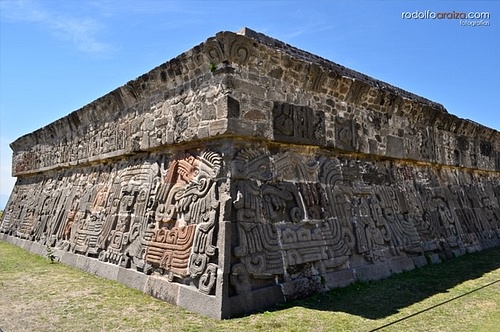
These intertwined stories of mythology and migration are typical of the transference of elements of Mesoamerican culture through the various contemporary and successive civilizations. Certainly, the two cities of Chichen Itza (in its second phase of development) and Toltec Tollan are remarkably similar in terms of layout, architecture, art, and iconography, suggesting there were historical cultural links between the Toltec and Yucatec Maya. Trade in obsidian (used for weapons) may well have been the reason the two cultures interacted but which one influenced or dominated the other is still a source of debate amongst scholars since the myths are fragmentary and they have been confused and mixed with later traditions. Further, the surviving physical evidence is contradictory. For example, wall paintings at Chichen Itza showing scenes of a naval invasion and brutal warfare do not match the story of a wise and benevolent outsider bringing peace and innovations to the Yucatan peninsula.
Quetzalcóatl - Feathered Serpent
Quetzalcóatl was one of the most important gods in ancient Mesoamerica, particularly for the Toltec and Aztec civilizations. He is also known as the Plumed or Feathered Serpent, that is, a mix of bird and rattlesnake. Indeed, his name is a combination of the Post-Classic Nahuatl words for the quetzal - the emerald plumed bird - and cóatl or serpent. Quetzalcóatl was regarded as the god of wind and rains, and as the creator of the world and humanity when he is often known as Ehecatl-Quetzalcóatl (ehecatl means wind in Nahuatl). In Central Mexico from 1200 CE, Quetzalcóatl was also considered the patron god of priests and merchants and the god of learning, science, agriculture, crafts, and the arts. He also invented the calendar, was identified with Venus, the rising morning star, and was associated with opossums. The god even discovered corn (maize) with the help of a giant red ant that led him to a mountain packed full of grain and seeds. Finally, Quetzalcóatl was associated with the nobility, rulers, and kingship, and his name was often taken to add prestige to a title, as we have seen above with Ce Acatl Topiltzin Quetzalcóatl.
Teotihuacan in the central basin of Mexico has the earliest representations of Quetzalcóatl, which date to the early 3rd century CE. These relief carvings show feathered snakes, and those at the later site of Cacaxtla include the god with rain and water. The god was often represented in architectural sculptural decoration, and he appears at other sites such as Xochicalco but rarely with any human form. Only from around 1200 CE is Quetzalcóatl given human features when he usually wears shell jewellery, yellow feathers, and a conical hat. The god sometimes wears the wind jewel (Ehecailacozcatl) which is a cross-section of a conch whorl worn as a pectoral.
Ehecatl - Wind God
Ehecatl was considered the wind aspect of Quetzalcóatl and so is another incarnation of Kukulcan. He was worshipped by the Aztecs and, before them, the Huastecs on the eastern coast of Mexico. Associated with the cardinal directions, the god was credited with giving humanity the maguey plant, a source of fibre for weaving and whose juice was fermented to make a mildly alcoholic milky beer known as pulque. According to one version of the Aztec creation myth, Quetzalcóatl took on the guise of Ehecatl and descended into the Underworld where he stole the bones of the inhabitants of the former worlds in order to create humans in this one.
Representations in art of Ehecatl-Quetzalcóatl often show him with a black body and a red mask like a duck's beak through which the god whistled up the winds. He also has long canine teeth and wears a conch shell pectoral. Unlike the typical pyramids which honour other gods, Ehecatl is usually honoured with aerodynamic wind temples, which are circular or curved at one end and topped with a conical roof. In a nod to his link with Kukulcan/Quetzalcóatl, the entrances of these temples are typically given a frame carved to resemble snake's jaws.
Gucumatz
As with Kukulcan for the Yucatec Maya, Gucumatz (or Gukumatz) was an important (but not the most important) god of the Quiché Maya (aka K'iche' Maya) who occupied what is today western Guatemala. Gucumatz, whose name means 'feathered serpent', appears in the Popol Vuh, a text which records the oral traditions of the creation, cosmology, and history of the Quiché. In the Popol Vuh, Gucumatz and the god Jurakan create the first world of the Quiché Maya, both the physical place and its inhabitants. The god was sometimes envisaged as an eagle, although in some myths he can also transform into a jaguar. In art, Gucumatz may also be represented as a conch shell, a snail or a bone flute. Gucumatz's secondary role in the Quiché creation mythology, where he appears with 12 other gods, suggests that he was an imported version of the Toltec Quetzalcóatl and the Yucatec Maya Kukulcan, and so he had to find a place in an existing pantheon. As with Kukulcan and Quetzalcóatl, the name Gucumatz was used by at least one Quiché ruler.
Chichen Itza
Chichen Itza flourished between 750 and 1200 CE, and today it is the Mesoamerican city most associated with Kukulcan. The city was likely the capital of a confederacy of Maya city-states. One structure associated with Kukulcan in his guise as the god of winds is the Caracol, an astronomical observatory built prior to 800 CE. Its impressive interior vaulting may have been designed to represent a conch shell which was an object associated with Kukulcan and most wind gods in Mesoamerica. The observatory was most likely built to track the progress of the planet Venus which was strongly associated with the feathered serpent god in all his forms.

Another impressive structure at the site is the Pyramid of Kukulcan, also known as the Castillo or Castle. Built prior to 1050 CE, the four-sided pyramid is 58-9 metres (190 ft) wide on each side and rises to a height of 24 metres (78 ft). A staircase on each side rises the nine levels to a summit where there is a small square structure consisting of two chambers. The pyramid is a marvel of architectural symmetry and design intention. Three stairways have 91 steps while the fourth has 92, making a total of 365, one step for each day of the year. Seen from above, the cross created by the stairways imposed on top of the square pyramid base recalls the Maya sign for zero. In addition, and in particular reference to Kukulcan, at certain times of the year, for example on the autumnal equinox, triangular shadows from the different levels of the pyramid are cast onto the sides of the northern staircase, giving the illusion a gigantic snake is climbing the structure built in honour of the feathered serpent god. A more conventional homage is seen in large stone snakeheads on the northern side of the pyramid. The platform at the pyramid's top was used for religious ceremonies in honour of Kukulcan which included human sacrifices, a reminder that in Mesoamerican culture the gods had to be continuously fed and appeased in order to ensure the continuance and prosperity of the human race.
